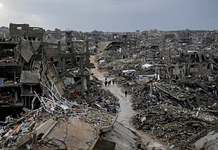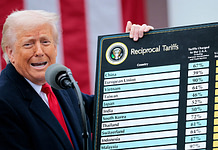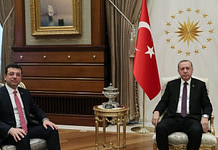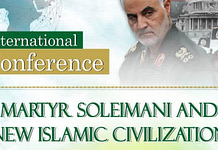1979, the destabilization’s year
Among the many events in international relations, two are, in our opinion, of pivotal importance for their contribution to the upsetting of the former geopolitical asset, based at the time on the conflict between the United States and the URSS.
We are speaking of the Islamic revolution in Iran and of the Russian military involvement in Afghanistan.
Following the takeover of Iran by the Ayatollah Khomeyni, one of the essential pillars of the western geopolitical architecture, with the USA as a leader, was destroyed.
The Pahlavi monarchy could easily be used as a pawn in the fight between the USA and the URSS, and when it disappeared both Washington and the Pentagon were forced to conceive a new role for the USA in the world politics. A new Iran, now autonomous and out of control, introduced a variation in the regional geopolitical chessboard, possibly able to induce a profound crisis in the steady bipolar system. Moreover, the new Iran, established as a regional power against the USA and Israel, possessed such characteristics (especially the geographic extent and centrality, and the political-religious homogeneity) as to compete for the hegemony on at least part of the Middle-East, in open contrast to similar interests of Ankara and Tel-Aviv, faithful allies of Washington, and of Islamabad. For such reasons, the Washington strategists, in agreement with their bicentenary “geopolitical of chaos”, persuaded the Iraq under Saddam Hussein to start a war against Iran. The destabilization of the whole area allowed Washington and the Western Countries enough time to plan a long-lasting strategy and in the meantime to wear down the soviet bear.
In an interview to the French weekly newspaper Le Nouvel Observateur (January 15-21, 1998, p. 76), Zbigniew Brzezinski, President Jimmy Carter’s national security adviser, revealed that CIA secretly operated in Afghanistan to undermine the power of the regime in Kabul since July, 1979, that is to say, five months before the Soviet invasion. Indeed, it was July 3, 1979, that President Carter signed the first directive for secret aid to the opponents of the pro-Soviet regime in Kabul. And that very day the US strategist of Polish origin wrote a note to President Carter in which he explained that this aid was going to induce a Soviet military intervention. And this was precisely what happened on the following December. In the same interview, Brzezinski remembers that, when the Soviet invaded Afghanistan, he wrote another note to President Carter in which he expressed his opinion that at that point the USA had the opportunity of giving to the USSR its Vietnam War.
In Brezinski’s opinion, this intervention was unsustainable for Moscow and in time would have led to the Soviet Empire collapse. In fact, the long war of the Soviets in support of the communist regime in Kabul further contributed to weaken the Soviet Union, already engaged in a severe internal crisis, concerning both political- bureaucratic and socio-economic aspects. As we now well know, the Soviet withdrawal from the afghan theater left behind an exhausted country, whose politics, economy and geo-strategic asset were extremely weak. As a matter of fact, after less than 10 years from the Teheran revolution, the entire region had been completely destabilized only to the advantage of the western system. The parallel and unrestrained decline of the Soviet Union, accelerated by the afghan adventure, and, afterwards in the nineties, the dismemberment of the Yugoslavian Federation (a sort of buffer state between the western and soviet blocks) changed the balance of power to favour the US expansionism in the Eurasia region.
After the bipolar system, a new geopolitical era began, that of the “unipolar moment”, in which the USA were the “hyperpuissance” (according to the definition of the French minister Hubert Védrin).
However, the new unipolar system was going to have a short life and indeed it ended at the beginning of the XXI century, when Russia re-emerged as a strategic challenger in global affairs and, at the same time, China and India, the two Asian giants, emerged as economic and strategic powers.
The geo-political cycles of Afghanistan
Afghanistan, due to its geographical characteristics, to its location as respect to the Soviet State (its neighbouring nations Turkmenistan, Uzbekistan and Tajikistan were, at that time, Soviet Republics), and to the wide variety of ethnic groups forming its population, different either in culture or in religion, represented for Washington an important portion of the so-called “arc of crisis”, namely that geographical region linking the southern boundaries of the USSR and the Arabian Sea. The Afghanistan trap for the URSS was therefore chosen for evident geopolitical and geostrategic reasons.
From the geopolitical point of view, Afghanistan is clearly representative of a crisis zone, being from time immemorial the scene for the conflicts among the Great Powers.
The area is now ruled by the Islamic Republic of Afghanistan, but traditionally the Pashtun tribes have dominated over the other ethnic groups (Tajiks, Hazaras, Uzbeks, Turkmens, Balochs). Its history was spent as part of larger events concerning the interaction and the prolonged fighting among the three neighbouring great geopolitical entities: the Moghul Empire, the Uzbek Khanate and the Persian Empire. In the XVIII and XIX centuries, when the Country was under the rule of the Kingdom of Afghanistan, the area became strategic in the rivalry and conflict between the British Empire and the Russian Empire for supremacy in Central Asia, termed “The Great Game”. The Russian land empire, in its efforts to secure access to the Indian Ocean, to India and to China, collided with the interests of the British maritime empire, that, for its part, sought to extend in the Eurasia landmass, using India as staging post, towards the East, to Burma, China, Tibet and the basin of the Yangtze river, and towards the West, to the present-day Pakistan, to Afghanistan and Iran, as far as the Caucasus, the Black Sea, to Mesopotamia and the Persian Gulf.
Towards the end of the XX century, in the frame of the bipolar system, Afghanistan became the battlefield where, once again, a maritime Power, the USA, confronted a land Power, the URSS.
Today, following the U.S.-led invasion of Afghanistan in 2001, the afghan trap, as boastfully Brzezinzki put it, has become the US marsh and nightmare.
Questo articolo è coperto da ©Copyright, per cui ne è vietata la riproduzione parziale o integrale. Per maggiori informazioni sull'informativa in relazione al diritto d'autore del sito visita Questa pagina.




















